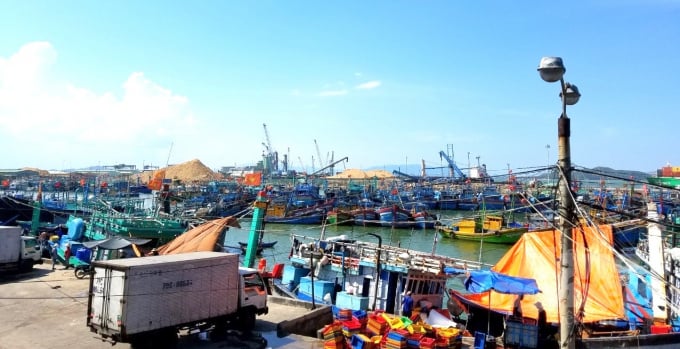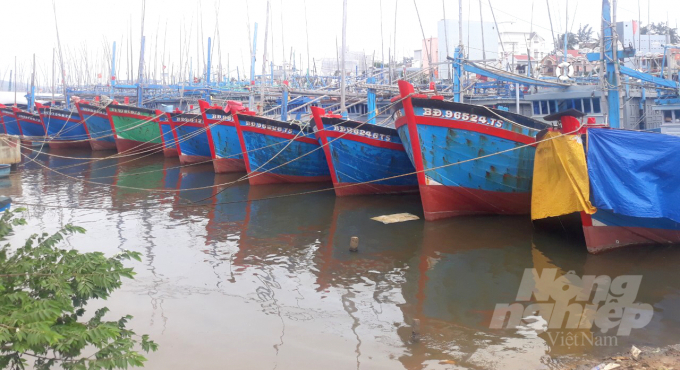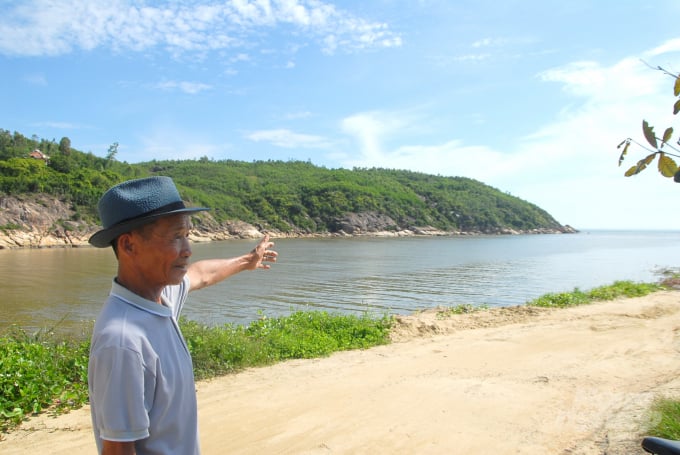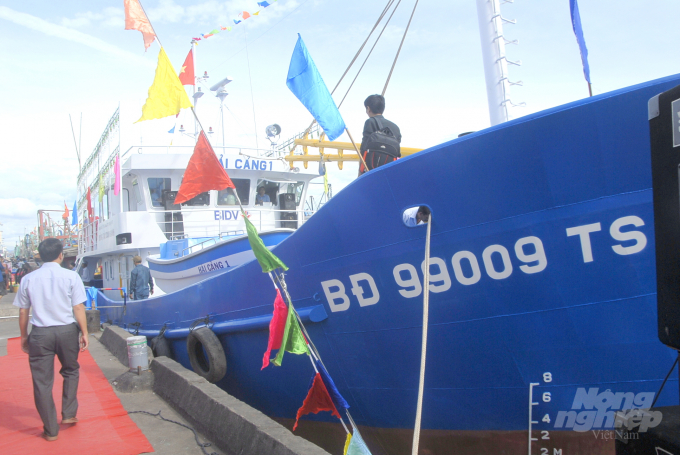November 28, 2025 | 01:51 GMT +7
November 28, 2025 | 01:51 GMT +7
Hotline: 0913.378.918
November 28, 2025 | 01:51 GMT +7
Hotline: 0913.378.918

Quy Nhon fishing port is overcrowded when the fishing boats of Binh Dinh fishermen dock. Photo: Vu Dinh Thung.
According to the Prime Minister’s Decision 1976/QD-TTg dated November 12, 2015 approving the planning of fishing port system and storm shelter system for fishing vessels to 2020, with a vision to 2030, Binh Dinh Province has four fishing ports, including one class I Quy Nhon fishing port and three Class 3 fishing ports De Gi, Nhon Chau and Tam Quan (specialised tuna port).
Quy Nhon port is currently a seafood trading center at regional level, having a great influence on fisheries activities in the province. Being put into use in 2012 with a total land area of 3.5 hectares, the number of fishing vessels coming through the port is 9,800 times/year and the total output of seafood is estimated at 37,000 tons/year. Besides essential facilities, the port is planning a fishery logistics service area which includes petrol stations, ice plant, fishing gears shop and catering services.

Tam Quan fishing port (Hoai Nhon town) is currently overloaded. Photo: Vu Dinh Thung.
De Gi port operated from 2014 with a total land area of 2.5 hectares. The number of fishing vessels coming through the port is 7,300 times/year and the total output is estimated at 9,600 tons/year. Nhon Chau port has completed the construction and put into use since 2000 with a total length of wharves reaching 85m, mainly serving local fishing vessels.
Meanwhile Tam Quan port has not yet been constructed. To serve the fishing activities here, along the two sides of the Tam Quan River, there are about 22 fishing spots owned by private wholesalers.
The development of Binh Dinh’s fisheries infrastructure is not matching with the strong growth of the fishing vessels, potentials and advantages of the province.
For example, the Tam Quan storm shelter, invested by the Ministry of Agriculture and Rural Development in 2007 and put into use in 2011, serves operation of only 1,000-1,200 fishing boats. Meanwhile, the total number of Hoai Nhon Town fishing fleet has 2,400 ships, thus the Tam Quan shelter is currently overloaded.

The canals of Tam Quan estuary (Hoai Nhon town) are often filled with sediment. Photo: Vu Dinh Thung.
While the canals of Tam Quan estuary are frequently filled up with sediment, offshore fishing boats are increasing in size and capacity, so getting in and out of Tam Quan estuary is very difficult and unsafe.
It can be said that the development of fisheries infrastructure in Binh Dinh is like "a too tight shirt" compared to the growth rate of the fishing force of this province. The provincial authority has outlined a roadmap to raise standards, improve quality and operational capacity for local fishing ports.
According to Tran Van Phuc, Director of Binh Dinh Department of Agriculture and Rural Development, to meet the needs of the local fisheries development, provincial People's Committee has proposed the Ministry of Agriculture and Rural Development to adjust and supplement the planning of storm shelter system in combination with the fishing port in Tam Quan, upgrading the Tam Quan port to the class I group with the water area of 20ha and the land area of 5ha.
Number of ships docking at the port is 300 times per day with the largest vessel size up to 1,000CV. The volume of seafood through the port is 40,000 tons/year, of which the tuna is 15,000 tons/year.
Another storm shelter is also proposed to be built in De Gi port in the next five years.

Offshore fishing vessels of Binh Dinh fishermen are increasing in size and capacity. Photo: Vu Dinh Thung.
For Tam Quan port, it requires comprehensive investment in infrastructure and equipment, improving management capacity and enhancing the value of fishery products and project management to reach the standard of class I.
This is the premise for the development of marine economy not only for the most powerful tuna fishing fleet in Hoai Nhon town but also for the whole province.
For the storm shelter in De Gi lagoon (Phu Cat district), the authority is making initial investment preparation. Earlier in August 2020, the Ministry of Agriculture and Rural Development issued a decision to prepare investment for the storm shelter in De Gi lagoon with a capacity of 2,000 fishing boats of 300-1,000CV size.

Over time of use and due to severe weather, the wharf of Nhon Chau port (Quy Nhon city) is deteriorating. Photo: Vu Dinh Thung.
Translated by Mai Huong

(VAN) On November 27, in the meeting with Minister Tran Duc Thang, Mayor Yin Yong shared Beijing’s experience to improve environment and air quality.

(VAN) After 30 years, both sides identified strategic areas of cooperation: sustainable production, increasing coffee value and training for farmers.
/2025/11/27/4910-4-164708_294.jpg)
(VAN) On the afternoon of November 27 in Beijing, Minister of Agriculture and Environment Tran Duc Thang held a working session with several major Chinese enterprises operating in the agriculture and environment sector.

(VAN) The Department of Animal Health issued a provisional guideline requesting local authorities to increase surveillance, collect samples for testing, and conduct epidemiological investigations according to the established procedure.

(VAN) The United Nations recommends that Vietnam utilize data and artificial intelligence to enhance early disaster warnings and reduce GDP losses by 3.2% in the context of climate change.

(VAN) On the morning of November 27 in Beijing, Minister Tran Duc Thang and the Deputy Commissioner General of the General Administration of Customs of China signed a protocol on fresh jackfruit exports.

(VAN) As floodwaters recede, a vast network of irrigation works across eastern Gia Lai is emerging in a state of severe disrepair, with extensive damage demanding urgent restoration ahead of the 2025-2026 winter-spring cropping season.